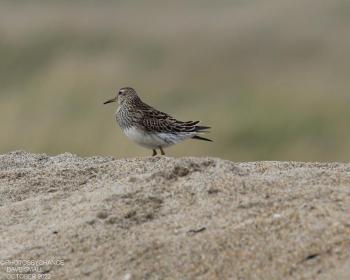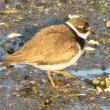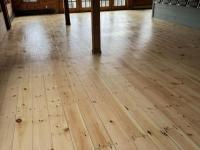What Happens in Maine Doesn't Stay in Maine
 A semipalmated sandpiper tagged in Georgia flew to the Seal River Watershed in Manitoba and then was detected in Maine on its way south in August. Courtesy of David Small
A semipalmated sandpiper tagged in Georgia flew to the Seal River Watershed in Manitoba and then was detected in Maine on its way south in August. Courtesy of David Small Pectoral sandpipers are one of a suite of shorebirds that travel from their Arctic breeding grounds to migratory stopover locations in Hudson and James Bays before leap-frogging over to the Maine coast before continuing on their way to South America. Courtesy of David Small
Pectoral sandpipers are one of a suite of shorebirds that travel from their Arctic breeding grounds to migratory stopover locations in Hudson and James Bays before leap-frogging over to the Maine coast before continuing on their way to South America. Courtesy of David Small Semipalmated plovers are a familiar sight along the Maine coast in spring and fall migration. They breed across the Arctic and Subarctic regions. Courtesy of Jeff Wells
Semipalmated plovers are a familiar sight along the Maine coast in spring and fall migration. They breed across the Arctic and Subarctic regions. Courtesy of Jeff Wells A semipalmated sandpiper tagged in Georgia flew to the Seal River Watershed in Manitoba and then was detected in Maine on its way south in August. Courtesy of David Small
A semipalmated sandpiper tagged in Georgia flew to the Seal River Watershed in Manitoba and then was detected in Maine on its way south in August. Courtesy of David Small Pectoral sandpipers are one of a suite of shorebirds that travel from their Arctic breeding grounds to migratory stopover locations in Hudson and James Bays before leap-frogging over to the Maine coast before continuing on their way to South America. Courtesy of David Small
Pectoral sandpipers are one of a suite of shorebirds that travel from their Arctic breeding grounds to migratory stopover locations in Hudson and James Bays before leap-frogging over to the Maine coast before continuing on their way to South America. Courtesy of David Small Semipalmated plovers are a familiar sight along the Maine coast in spring and fall migration. They breed across the Arctic and Subarctic regions. Courtesy of Jeff Wells
Semipalmated plovers are a familiar sight along the Maine coast in spring and fall migration. They breed across the Arctic and Subarctic regions. Courtesy of Jeff Wells
We have recently been checking the amazing MOTUS wildlife tracking database run by Birds Canada (https://motus.org/) and have found some interesting bird migration connections to Maine.
One of these involves a semipalmated sandpiper, a small shorebird with brownish-tan upperparts, white underparts, and black bill and legs. In spring and fall migration, small flocks of these birds can be found picking and probing for tiny crustaceans on mud flats, sandy beaches, and in shallow salt marsh pools. Semipalmated sandpipers breed in the Arctic and subarctic south to Hudson Bay and James Bay. They winter regularly south to coastal Brazil and Peru.
Last May, researchers on the coast of Georgia tagged some of these birds with MOTUS tags. A number of them were registered in early June as they migrated north past MOTUS towers in the Seal River Watershed of northern Manitoba, a 12-million-acre watershed that four First Nations are working to protect, together with the governments of Manitoba and Canada. One of these semipalmated sandpipers was detected the following August at a MOTUS station 1,500 miles away—at Petit Manan Manan Point in Washington County, Maine!
This is just one of the many connections we have here in Maine with the Hudson-James Bay region. Lots of red knots, semipalmated plovers, least sandpipers, pectoral sandpipers, lesser yellowlegs, black-bellied plovers, and others have been tracked moving from Hudson and James Bay to Maine in fall migration. Some of these species breed in the vast marshes and peatlands around Hudson and James Bay. Others breed farther north in the Arctic and come south to the rich ecosystems of that region to fatten up for the long migration south, sometimes as far south as Argentina and Chile. The Mushkegowuk Council, which represents a group of First Nations in northern Ontario, is working on massive large-scale conservation in that region. This includes a proposal for a 20-million-acre marine protected area adjacent to the coast of Ontario.
Another awesome bird migration connection was registered in September at the MOTUS station located at the National Audubon camp at Hog Island in Bremen. It was a white-rumped sandpiper captured and tagged in July in the Arctic at a place called Prince Charles Island, just off the West Coast of Baffin Island (Qikiqtaaluk). Ebird checklists from the island show that this white-rumped sandpiper was surrounded by cool birds like king eiders, long-tailed ducks, brant, and sabine’s gulls all summer. Polar bears certainly may have wandered by.
And then this bird flew south, eventually making its way 1,700 miles to the coast of Maine. Although we don’t have more tag registrations of this particular bird, we know that white-rumped sandpipers travel all the way to the southern coast of South America to spend the northern hemisphere winter in the southern hemisphere summer.
There are some inspiring conservation initiatives going on in the Arctic region of Canada led by Inuit governments and leaders. One of these is the Nunavut Land-Use Plan that, if finalized, would be one of the world’s most significant conservation achievements. And just a few days ago, the Qikiqtani Inuit Association announced it had formally begun implementation of the Sinaa conservation agreement that will eventually result in conservation of tens of millions of acres of lands and waters in the Qikiqtani region of Nunavut.
Isn’t it fascinating to see how these bird ambassadors show the shared responsibilities we have with peoples and governments around the world? What happens in Maine doesn’t stay in Maine, and that’s a beautiful thing!
Jeffrey V. Wells, Ph.D., is a Fellow of the Cornell Lab of Ornithology and Vice President of Boreal Conservation for National Audubon. Dr. Wells is one of the nation's leading bird experts and conservation biologists. He is a coauthor of the seminal “Birds of Maine” book and author of the “Birder’s Conservation Handbook.” His grandfather, the late John Chase, was a columnist for the Boothbay Register for many years. Allison Childs Wells, formerly of the Cornell Lab of Ornithology, is a senior director at the Natural Resources Council of Maine, a nonprofit membership organization working statewide to protect the nature of Maine. Both are widely published natural history writers and are the authors of the popular books, “Maine’s Favorite Birds” (Down East Books) and “Birds of Aruba, Bonaire, and Curaçao: A Site and Field Guide,” (Cornell University Press).




























